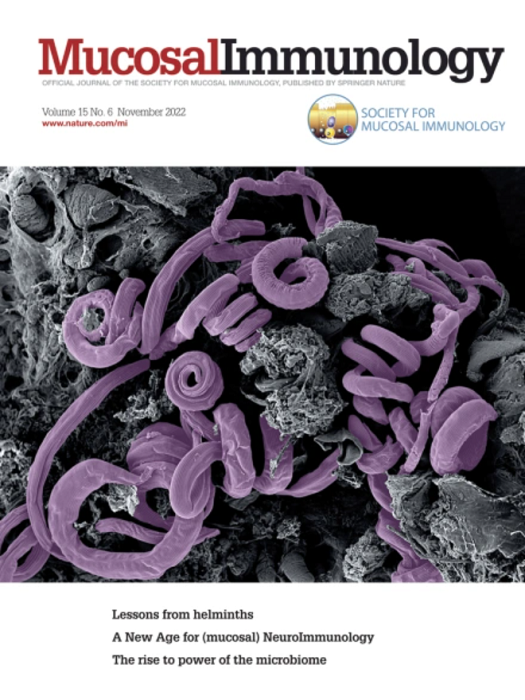Card9和MyD88对小鼠皮肤中Th17对共生酵母马拉色菌的免疫有不同的调节作用。
IF 7.9
2区 医学
Q1 IMMUNOLOGY
引用次数: 0
摘要
皮肤微生物组中的真菌群落主要由马拉色菌这一单一菌属组成。除了在宿主界面的共生生活方式外,这种共生酵母菌还与人类和宠物的各种炎症性皮肤病有关。稳定的定植是通过 17 型抗真菌免疫来维持的。然而,Th17 对马拉色菌反应的驱动机制仍不清楚。在这里,我们发现 C 型凝集素受体 Mincle、Dectin-1 和 Dectin-2 能够识别马拉色菌细胞壁中的保守模式,并在体外诱导树突状细胞活化,而在体内实验性皮肤定植过程中,只有 Dectin-2 是 Th17 活化所必需的。相反,在这种情况下,Toll 样受体的识别是多余的。相反,通过 MyD88 发出信号的炎性 IL-1 家族细胞因子也以 T 细胞内在的方式参与了 Th17 的激活。综上所述,我们描述了针对皮肤真菌生物群中最丰富成员的保护性免疫的途径。这些知识有助于人们了解屏障免疫及其受共生体的调控,考虑到异常免疫反应与严重皮肤病症的关联,这些知识具有重要意义。本文章由计算机程序翻译,如有差异,请以英文原文为准。
Card9 and MyD88 differentially regulate Th17 immunity to the commensal yeast Malassezia in the murine skin
The fungal community of the skin microbiome is dominated by a single genus, Malassezia. Besides its symbiotic lifestyle at the host interface, this commensal yeast has also been associated with diverse inflammatory skin diseases in humans and pet animals. Stable colonization is maintained by antifungal type 17 immunity. The mechanisms driving Th17 responses to Malassezia remain, however, unclear. Here, we show that the C-type lectin receptors Mincle, Dectin-1, and Dectin-2 recognize conserved patterns in the cell wall of Malassezia and induce dendritic cell activation in vitro, while only Dectin-2 is required for Th17 activation during experimental skin colonization in vivo. In contrast, Toll-like receptor recognition was redundant in this context. Instead, inflammatory IL-1 family cytokines signaling via MyD88 were also implicated in Th17 activation in a T cell-intrinsic manner. Taken together, we characterized the pathways contributing to protective immunity against the most abundant member of the skin mycobiome. This knowledge contributes to the understanding of barrier immunity and its regulation by commensals and is relevant considering how aberrant immune responses are associated with severe skin pathologies.
求助全文
通过发布文献求助,成功后即可免费获取论文全文。
去求助
来源期刊

Mucosal Immunology
医学-免疫学
CiteScore
16.60
自引率
3.80%
发文量
100
审稿时长
12 days
期刊介绍:
Mucosal Immunology, the official publication of the Society of Mucosal Immunology (SMI), serves as a forum for both basic and clinical scientists to discuss immunity and inflammation involving mucosal tissues. It covers gastrointestinal, pulmonary, nasopharyngeal, oral, ocular, and genitourinary immunology through original research articles, scholarly reviews, commentaries, editorials, and letters. The journal gives equal consideration to basic, translational, and clinical studies and also serves as a primary communication channel for the SMI governing board and its members, featuring society news, meeting announcements, policy discussions, and job/training opportunities advertisements.
 求助内容:
求助内容: 应助结果提醒方式:
应助结果提醒方式:


